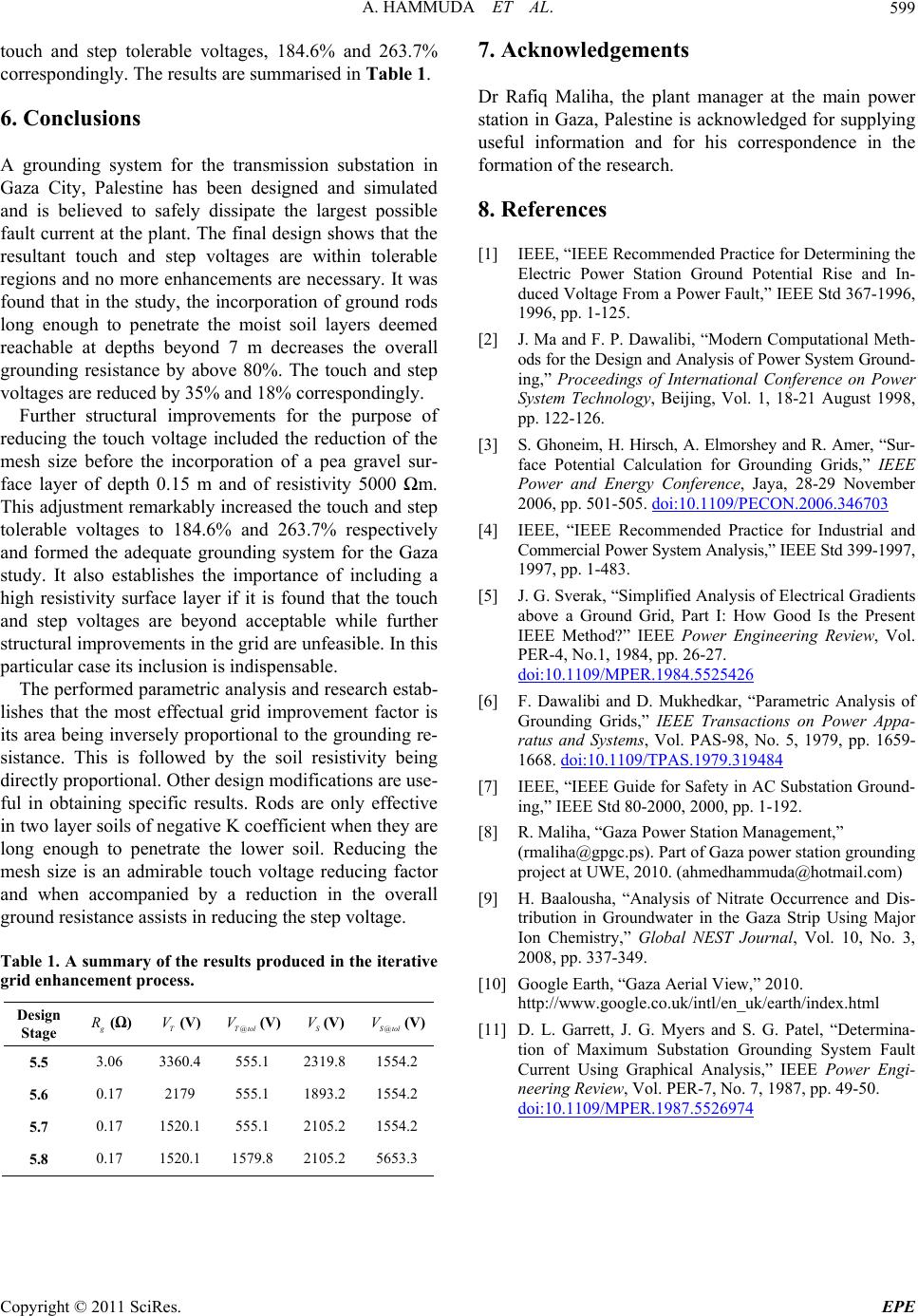
A. HAMMUDA ET AL.
Copyright © 2011 SciRes. EPE
599
7. Acknowledgements touch and step tolerable voltages, 184.6% and 263.7%
correspondingly. The results are summarised in Table 1.
Dr Rafiq Maliha, the plant manager at the main power
station in Gaza, Palestine is acknowledged for supplying
useful information and for his correspondence in the
formation of the research.
6. Conclusions
A grounding system for the transmission substation in
Gaza City, Palestine has been designed and simulated
and is believed to safely dissipate the largest possible
fault current at the plant. The final design shows that the
resultant touch and step voltages are within tolerable
regions and no more enhancements are necessary. It was
found that in the study, the incorporation of ground rods
long enough to penetrate the moist soil layers deemed
reachable at depths beyond 7 m decreases the overall
grounding resistance by above 80%. The touch and step
voltages are reduced by 35% and 18% correspondingly.
8. References
[1] IEEE, “IEEE Recommended Practice for Determining the
Electric Power Station Ground Potential Rise and In-
duced Voltage From a Power Fault,” IEEE Std 367-1996,
1996, pp. 1-125.
[2] J. Ma and F. P. Dawalibi, “Modern Computational Meth-
ods for the Design and Analysis of Power System Ground-
ing,” Proceedings of International Conference on Power
System Technology, Beijing, Vol. 1, 18-21 August 1998,
pp. 122-126.
Further structural improvements for the purpose of
reducing the touch voltage included the reduction of the
mesh size before the incorporation of a pea gravel sur-
face layer of depth 0.15 m and of resistivity 5000 Ωm.
This adjustment remarkably increased the touch and step
tolerable voltages to 184.6% and 263.7% respectively
and formed the adequate grounding system for the Gaza
study. It also establishes the importance of including a
high resistivity surface layer if it is found that the touch
and step voltages are beyond acceptable while further
structural improvements in the grid are unfeasible. In this
particular case its inclusion is indispensable.
[3] S. Ghoneim, H. Hirsch, A. Elmorshey and R. Amer, “Sur-
face Potential Calculation for Grounding Grids,” IEEE
Power and Energy Conference, Jaya, 28-29 November
2006, pp. 501-505. doi:10.1109/PECON.2006.346703
[4] IEEE, “IEEE Recommended Practice for Industrial and
Commercial Power System Analysis,” IEEE Std 399-1997,
1997, pp. 1-483.
[5] J. G. Sverak, “Simplified Analysis of Electrical Gradients
above a Ground Grid, Part I: How Good Is the Present
IEEE Method?” IEEE Power Engineering Review, Vol.
PER-4, No.1, 1984, pp. 26-27.
doi:10.1109/MPER.1984.5525426
The performed parametric analysis and research estab-
lishes that the most effectual grid improvement factor is
its area being inversely proportional to the grounding re-
sistance. This is followed by the soil resistivity being
directly proportional. Other design modifications are use-
ful in obtaining specific results. Rods are only effective
in two layer soils of negative K coefficient when they are
long enough to penetrate the lower soil. Reducing the
mesh size is an admirable touch voltage reducing factor
and when accompanied by a reduction in the overall
ground resistance assists in reducing the step voltage.
[6] F. Dawalibi and D. Mukhedkar, “Parametric Analysis of
Grounding Grids,” IEEE Transactions on Power Appa-
ratus and Systems, Vol. PAS-98, No. 5, 1979, pp. 1659-
1668. doi:10.1109/TPAS.1979.319484
[7] IEEE, “IEEE Guide for Safety in AC Substation Ground-
ing,” IEEE Std 80-2000, 2000, pp. 1-192.
[8] R. Maliha, “Gaza Power Station Management,”
(rmaliha@gpgc.ps). Part of Gaza power station grounding
project at UWE, 2010. (ahmedhammuda@hotmail.com)
[9] H. Baalousha, “Analysis of Nitrate Occurrence and Dis-
tribution in Groundwater in the Gaza Strip Using Major
Ion Chemistry,” Global NEST Journal, Vol. 10, No. 3,
2008, pp. 337-349.
Table 1. A summary of the results produced in the iterative
grid enhancement process. [10] Google Earth, “Gaza Aerial View,” 2010.
http://www.google.co.uk/intl/en_uk/earth/index.html
Design
Stage
(Ω) T
V(V) @Ttol
V(V) S
V(V) @Stol
V(V)
5.5 3.06 3360.4 555.1 2319.8 1554.2
5.6 0.17 2179 555.1 1893.2 1554.2
5.7 0.17 1520.1 555.1 2105.2 1554.2
5.8 0.17 1520.1 1579.8 2105.2 5653.3
[11] D. L. Garrett, J. G. Myers and S. G. Patel, “Determina-
tion of Maximum Substation Grounding System Fault
Current Using Graphical Analysis,” IEEE Power Engi-
neering Revie w, Vol. PER-7, No. 7, 1987, pp. 49-50.
doi:10.1109/MPER.1987.5526974